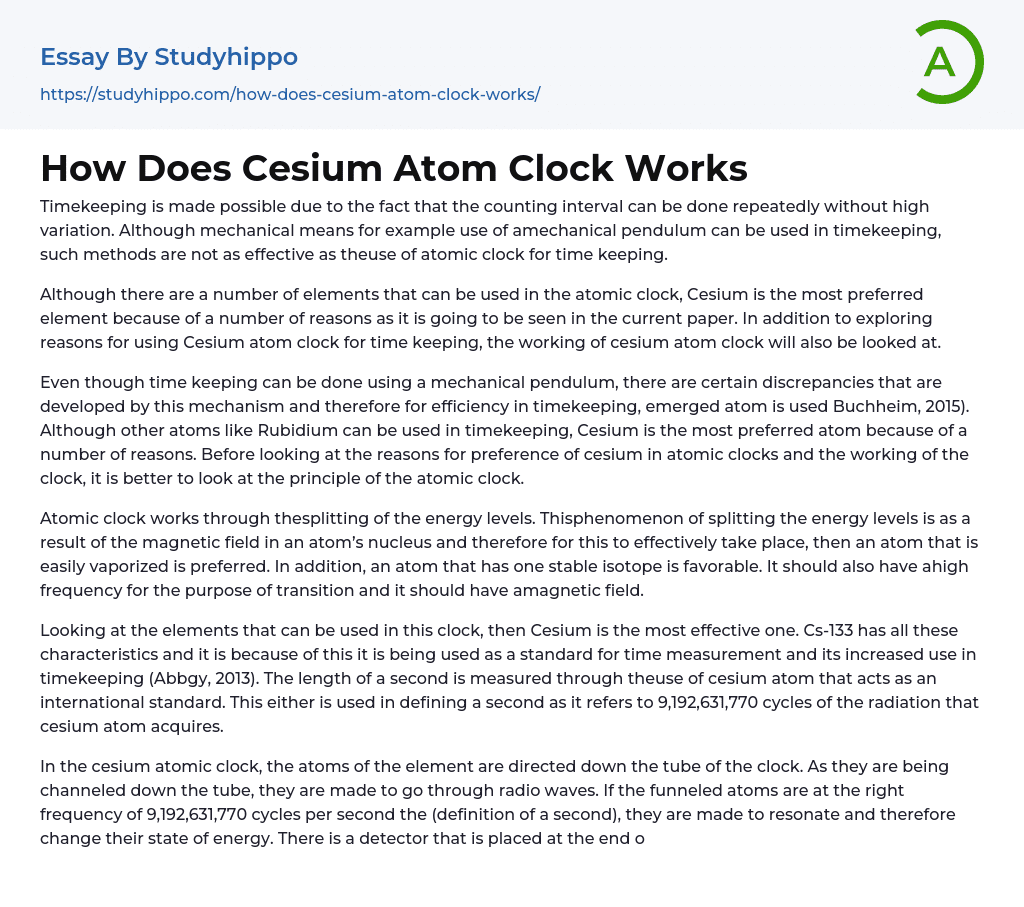Timekeeping is made possible due to the fact that the counting interval can be done repeatedly without high variation. Although mechanical means for example use of amechanical pendulum can be used in timekeeping, such methods are not as effective as theuse of atomic clock for time keeping.
Although there are a number of elements that can be used in the atomic clock, Cesium is the most preferred element because of a number of reasons as it is going to be seen in the current paper. In addition to exploring reasons for using Cesium atom clock for time keeping, the working of cesium atom clock will also be looked at.
Even though time keeping can be done using a mechanical pendulum, there are certain discrepancies that are developed by this mechanism and therefore for efficiency in timekeeping, emerged atom i
...s used Buchheim, 2015). Although other atoms like Rubidium can be used in timekeeping, Cesium is the most preferred atom because of a number of reasons. Before looking at the reasons for preference of cesium in atomic clocks and the working of the clock, it is better to look at the principle of the atomic clock.
Atomic clock works through thesplitting of the energy levels. Thisphenomenon of splitting the energy levels is as a result of the magnetic field in an atom’s nucleus and therefore for this to effectively take place, then an atom that is easily vaporized is preferred. In addition, an atom that has one stable isotope is favorable. It should also have ahigh frequency for the purpose of transition and it should have amagnetic field.
Looking at the elements that can be used in this clock, then Cesiu
is the most effective one. Cs-133 has all these characteristics and it is because of this it is being used as a standard for time measurement and its increased use in timekeeping (Abbgy, 2013). The length of a second is measured through theuse of cesium atom that acts as an international standard. This either is used in defining a second as it refers to 9,192,631,770 cycles of the radiation that cesium atom acquires.
In the cesium atomic clock, the atoms of the element are directed down the tube of the clock. As they are being channeled down the tube, they are made to go through radio waves. If the funneled atoms are at the right frequency of 9,192,631,770 cycles per second the (definition of a second), they are made to resonate and therefore change their state of energy. There is a detector that is placed at the end of the tube that counts the number of cesium atoms whose energy states have been changed.
It should be noted that the number of the atoms that comes into contact with the detector is determined by the tuning of the radio wave frequency to the established international standard in measuring time. As the cesium atom gets into contact with the detector, it then sends the information back to the clock’s radio wave generator. The generator then coordinates the frequency registered as a result of the radio waves with the highest number of the atoms that are striking it. Electronics that are used in the clock then count the frequency. A frequency count is then used to indicate a second and hence timekeeping (Milonni&Eberly, 2010).
As already mentioned, unlike other mechanism
that are used in time measuring including use of pendulums, the cesium atomic clock is more accurate as the electrons that cycle the nucleus of an atom that moves back and forth in between the energy states are more accurate and precisely count the seconds and therefore effective for timekeeping (Abbgy, 2013). Compared to other atoms that can be used, cesium atom is more effective as it has the aspects that align with the principle of anatomic clock.
- Atom essays
- Big Bang Theory essays
- Density essays
- Electricity essays
- Energy essays
- Force essays
- Heat essays
- Light essays
- Motion essays
- Nuclear Power essays
- Physiology essays
- Sound essays
- Speed essays
- Temperature essays
- Thermodynamics essays
- Acid essays
- Calcium essays
- Carbohydrate essays
- Carbon essays
- Chemical Bond essays
- Chemical Reaction essays
- Chemical reactions essays
- Chromatography essays
- Concentration essays
- Copper essays
- Diffusion essays
- Ethanol essays
- Hydrogen essays
- Organic Chemistry essays
- Osmosis essays
- Periodic Table essays
- Ph essays
- Salt essays
- Sodium essays
- Titration essays




